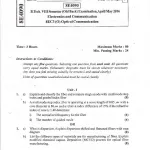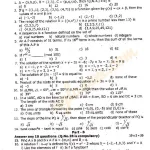Sample Questions and Answers
What is the function of the cell membrane?
The cell membrane controls the movement of substances in and out of the cell. It acts as a protective barrier and maintains the cell’s environment.
What is the difference between plant cells and animal cells?
Plant cells have a cell wall, chloroplasts, and a large central vacuole, while animal cells do not. Animal cells have centrioles, which are usually absent in plant cells.
Why are mitochondria known as the powerhouse of the cell?
Mitochondria produce energy in the form of ATP through cellular respiration, which is why they are called the powerhouse of the cell.
What is photosynthesis?
Photosynthesis is the process in which green plants use sunlight, carbon dioxide, and water to make their own food and release oxygen.
What is the role of chlorophyll in photosynthesis?
Chlorophyll absorbs sunlight, which is essential for converting light energy into chemical energy during photosynthesis.
What is the function of the nucleus in a cell?
The nucleus controls all the activities of the cell and contains genetic material (DNA) that determines the traits of an organism.
What is a food chain?
A food chain shows the flow of energy from one organism to another in an ecosystem. It starts with producers and ends with top consumers.
What is an ecosystem?
An ecosystem is a community of living organisms interacting with their physical environment, including air, water, and soil.
What is the difference between herbivores, carnivores, and omnivores?
Herbivores eat plants, carnivores eat other animals, and omnivores eat both plants and animals.
Why is water important for living organisms?
Water is essential for all life processes, including digestion, circulation, and temperature regulation in living organisms.
What are decomposers? Give examples.
Decomposers break down dead organisms and recycle nutrients back into the environment. Examples include fungi and bacteria.
What are the different types of reproduction in living organisms?
There are two types of reproduction: asexual reproduction, where offspring arise from a single parent, and sexual reproduction, which involves two parents.
What are the main parts of a flower?
The main parts of a flower are sepals, petals, stamens (male reproductive part), and carpels (female reproductive part).
What is the difference between xylem and phloem?
Xylem transports water and minerals from roots to leaves, while phloem transports food from leaves to different parts of the plant.
What is the function of roots in plants?
Roots absorb water and minerals from the soil, anchor the plant, and store food in some plants.
What are the different types of joints in the human body?
The human body has different types of joints, including hinge joints (knees, elbows), ball and socket joints (shoulders, hips), and pivot joints (neck).
What is respiration in living organisms?
Respiration is the process of breaking down food to release energy. It can be aerobic (with oxygen) or anaerobic (without oxygen).
What is the importance of vaccination?
Vaccination helps protect against diseases by stimulating the immune system to produce antibodies against harmful pathogens.
What is the difference between arteries and veins?
Arteries carry oxygen-rich blood away from the heart, while veins carry oxygen-poor blood back to the heart.
What are hormones? Give examples.
Hormones are chemical messengers that regulate body functions. Examples include insulin (regulates blood sugar) and adrenaline (prepares the body for emergencies).
What is digestion?
Digestion is the process of breaking down food into simpler substances so the body can absorb nutrients and use them for energy.
Why do we need proteins in our diet?
Proteins are essential for growth, repair of tissues, and making enzymes and hormones in the body.
What is the function of red blood cells in the body?
Red blood cells transport oxygen from the lungs to the rest of the body and carry carbon dioxide back to the lungs for exhalation.
What is the role of white blood cells in the immune system?
White blood cells fight infections by attacking harmful bacteria, viruses, and other foreign substances.
What are vitamins and why are they important?
Vitamins are essential nutrients that help in body functions like immunity, growth, and metabolism. For example, Vitamin C boosts immunity, and Vitamin D strengthens bones.
What is the difference between communicable and non-communicable diseases?
Communicable diseases spread from person to person through air, water, or contact (e.g., flu, COVID-19), while non-communicable diseases do not spread (e.g., diabetes, heart disease).
Why do leaves appear green?
Leaves appear green because they contain chlorophyll, which absorbs all colors of light except green, which is reflected.
What is the main function of the heart?
The heart pumps blood throughout the body, supplying oxygen and nutrients to tissues and removing waste products.
What is the difference between a habitat and a niche?
A habitat is the place where an organism lives, while a niche is its role in the ecosystem, including its interactions with other organisms.
What is adaptation in living organisms?
Adaptation is a feature or behavior that helps an organism survive in its environment, such as thick fur in polar bears for cold climates.
Why do fish have gills instead of lungs?
Fish have gills to extract oxygen from water, whereas lungs are adapted for breathing air.
What is the process of excretion?
Excretion is the removal of waste products from the body, such as sweat, urine, and carbon dioxide.
What is the function of the liver in the human body?
The liver helps in digestion by producing bile, stores nutrients, and removes toxins from the blood.
What is the difference between a unicellular and a multicellular organism?
A unicellular organism has only one cell (e.g., bacteria), while a multicellular organism has many cells (e.g., humans, plants).
Why are amphibians called cold-blooded animals?
Amphibians are called cold-blooded because their body temperature changes with the environment.
What is the function of the kidneys in the human body?
The kidneys filter waste from the blood and produce urine to remove excess water and toxins.
What is biodiversity?
Biodiversity refers to the variety of life forms on Earth, including different species of plants, animals, and microorganisms.
What are greenhouse gases? Give examples.
Greenhouse gases trap heat in the atmosphere and contribute to global warming. Examples include carbon dioxide, methane, and water vapor.
Why is deforestation harmful to the environment?
Deforestation leads to habitat loss, reduces oxygen levels, increases carbon dioxide, and contributes to climate change.
What is the function of stomata in plants?
Stomata are tiny pores on leaves that help in gas exchange and transpiration.
What is the main cause of soil erosion?
Soil erosion is caused by wind, water, and human activities like deforestation and overgrazing.
Why do some animals hibernate?
Some animals hibernate to survive cold winters when food is scarce by reducing their body temperature and metabolic rate.
What is the difference between renewable and non-renewable resources?
Renewable resources can be replenished (e.g., sunlight, wind), while non-renewable resources are limited and take millions of years to form (e.g., coal, oil).
What is the main source of energy for life on Earth?
The Sun is the main source of energy, providing light and heat necessary for life and photosynthesis.
How does pollution affect human health?
Pollution can cause respiratory diseases, allergies, and other health problems due to harmful chemicals in the air, water, and soil.
Best Indian Books for Class 8 Biology Question Paper 2017
-
NCERT Science (Class 8) – NCERT Publication
This book includes chapter-wise explanations, diagrams, and exercise questions, including multiple-choice questions (MCQs), short answer questions, and long answer questions. -
S Chand’s Science for Class 8 – B.K. Gowel (S Chand Publications)
Covers in-depth concepts with real-life examples and practice questions, including fill in the blanks, match the following, and detailed theoretical explanations. -
All in One Science Class 8 – Arihant Experts (Arihant Publications)
Contains topic-wise explanations, previous year’s question papers, sample papers, and objective as well as subjective questions for practice. -
Together With Science Class 8 – Rachna Sagar Publications
Provides conceptual clarity with practical applications, case-based questions, HOTS (Higher Order Thinking Skills) questions, and assertion-reason questions. -
MTG Foundation Course Science – MTG Editorial Board (MTG Learning Media)
Includes chapter-wise topic explanations with diagrams, MCQs, Olympiad-based questions, and competitive exam-oriented questions. -
Lakhmir Singh & Manjit Kaur Science Class 8 – Lakhmir Singh, Manjit Kaur (S Chand Publications)
A student-friendly book with easy explanations, solved examples, and a variety of questions, including true/false, diagram-based questions, and reasoning-based questions. -
ICSE Biology for Class 8 – Dr. S.P. Tripathi (Viva Education)
Specifically designed for ICSE students, this book includes in-depth theory, activity-based learning, and practice questions such as label-the-diagram and one-word answer questions. -
Oswaal CBSE Question Bank Science Class 8 – Oswaal Books
Contains previous year’s question papers, sample papers, mind maps, and concept-based questions for exam preparation. -
Foundation Science Biology Class 8 – H.C. Verma (Bharti Bhawan Publications)
A strong conceptual book with clear explanations and application-based questions, including numerical biology questions and conceptual case studies. -
Dinesh Science Class 8 – P.S. Verma (Dinesh Publications)
Detailed book for CBSE and ICSE students with HOTS, MCQs, fill in the blanks, and long answer questions based on real-world examples. -
Concise Biology Class 8 – Selina Publishers
A well-structured book for ICSE students with diagram-based questions, short explanations, and practical-based questions. -
RD Sharma Science Class 8 – RD Sharma (Dhanpat Rai Publications)
Includes concept-based explanations and a variety of practice questions, such as assertion-reason, match the following, and case-study-based questions. -
CBSE Science Success Guide Class 8 – Full Marks Publications
Offers chapter summaries, important concepts, and a variety of question types, including competency-based and practice worksheets. -
Navneet Science Digest Class 8 – Navneet Publications
Includes detailed explanations, practice sets, previous years’ exam questions, and model test papers. -
Pearson Science Class 8 – Pearson India
A structured book with real-life applications, multiple-choice questions, assertion-reason questions, and diagram-based explanations. -
Exemplar Science Class 8 – NCERT (NCERT Publication)
Focuses on HOTS, reasoning-based questions, case-study questions, and experimental-based MCQs for deeper understanding. -
Xam Idea Science Class 8 – VK Global Publications
Includes concept notes, solved questions, and practice exercises, along with sample question papers based on the latest exam pattern. -
New Simplified Science Class 8 – S.K. Aggarwal (Dhanpat Rai Publications)
Provides theoretical and practical learning with diagrammatic explanations, chapter-wise tests, and past board questions. -
Evergreen Science Class 8 – Evergreen Publications
Features detailed explanations, HOTS questions, assertion-reasoning, and mind maps for better retention. -
Pradeep’s Science for Class 8 – K.L. Gogia (Pradeep Publications)
A comprehensive book with advanced concepts, detailed diagrams, and practice questions, including application-based and numerical questions.
These books are useful for students preparing for their Class 8 Biology exams and cover a wide range of question types.
8 Class Biology Question Paper 2017 – Expert Insights & Preparation Guide
The Class 8 Biology question paper from 2017 remains an essential resource for students aiming to strengthen their foundational knowledge. Whether preparing for school exams or competitive tests, reviewing past papers helps in understanding the question pattern, marking scheme, and key topics.
Why Solving the 2017 Biology Question Paper is Important?
Studying previous years’ question papers allows students to recognize frequently asked topics, practice time management, and gain confidence before the exam. It also helps in identifying weak areas that need extra attention. Many concepts covered in Class 8 form the base for higher studies in science, making it crucial to grasp them thoroughly.
Key Topics Covered in Class 8 Biology 2017 Question Paper
The Class 8 Biology syllabus includes various important topics related to life sciences, the environment, and human health. Some of the core topics that appeared in the 2017 paper include:
- Cell Structure and Functions – Understanding plant and animal cells, organelles, and their functions.
- Microorganisms: Friend and Foe – The role of bacteria, fungi, and viruses in our lives.
- Reproduction in Animals and Plants – Asexual and sexual reproduction, including pollination and fertilization.
- Human Body Systems – Digestive, respiratory, circulatory, and nervous systems.
- Ecosystem and Conservation – Importance of biodiversity, food chains, and food webs.
- Diseases and Their Prevention – Infectious and non-infectious diseases, vaccines, and immunity.
These topics frequently appear in CBSE, ICSE, and state board exams.
Types of Questions Asked in the 2017 Paper
The 2017 Class 8 Biology paper had a mix of different question formats:
- Multiple-Choice Questions (MCQs) – Quick-answer questions testing basic concepts.
- Short Answer Questions – Concept-based questions requiring explanations in a few sentences.
- Diagram-Based Questions – Labeling and explaining biological diagrams such as the human digestive system or plant cells.
- Long Answer Questions – In-depth descriptive questions requiring detailed explanations.
- Assertion-Reason Questions – Analytical questions that test logical reasoning and conceptual clarity.
Expert Tips for Solving Class 8 Biology Question Papers
1. Focus on Conceptual Understanding
Biology is not about memorization alone. Understanding how different systems work, their interrelations, and their real-world applications helps in answering questions accurately.
2. Practice Diagrams Regularly
Many questions in Class 8 Biology involve labeled diagrams. Practicing diagrams like plant cells, human hearts, and food chains ensures that you can recreate them correctly in exams.
3. Revise NCERT and Other Standard Books
NCERT textbooks are the primary source for exam questions. Reading and revising all chapters thoroughly will improve comprehension and recall ability.
4. Solve Previous Year Papers and Sample Papers
Attempting the 2017 paper and other past papers gives insight into the exam format and helps in managing time effectively.
5. Prepare Notes for Quick Revision
Summarizing important points, definitions, and diagrams in a notebook makes last-minute revision easier.
6. Focus on Application-Based Questions
Many modern exams include real-life application questions. Understanding the practical relevance of biological concepts enhances problem-solving skills.
7. Manage Time Effectively in Exams
Start with easier questions to build confidence and save time for long-answer and diagram-based questions. Keep an eye on the clock to ensure all questions are attempted.
8. Practice with Online Tests and Mock Exams
Online quizzes and mock tests provide a competitive edge by simulating real exam conditions.
FAQ for 8 Class Biology Question Paper 2017
What are the important topics to focus on in Class 8 Biology?
Key topics include cell structure, reproduction, microorganisms, human body systems, diseases, and environmental conservation.
How can I prepare effectively for the Biology exam?
Start with textbook reading, practice diagrams, solve past papers, and revise with short notes for better retention.
Are diagrams important in the Class 8 Biology exam?
Yes, diagram-based questions are common. Practice labeled diagrams for cell structures, human organs, and ecosystems.
How many types of questions are asked in the Biology paper?
The paper includes MCQs, short answer, long answer, diagram-based, and assertion-reasoning questions.
Is the 2017 Biology question paper still useful for preparation?
Yes, solving past question papers helps in understanding exam patterns and frequently asked topics.
What is the best way to memorize scientific terms?
Use flashcards, mnemonics, and visualization techniques to remember complex biological terms easily.
Are NCERT books enough for Class 8 Biology preparation?
NCERT books are the primary source, but additional reference books like S Chand and Lakhmir Singh help in better understanding.
How do I improve my answering skills in Biology exams?
Write precise and structured answers, include keywords, and draw labeled diagrams where required.
Can I find the 2017 question paper with solutions online?
Many educational platforms provide previous year question papers with solutions for practice.
How much time should I spend on Biology exam preparation?
A consistent study plan with at least 1–2 hours daily for revision and practice ensures strong preparation.
Latest Posts
- Step-by-step guide to download and apply for jee mains admit card 202
- Comprehensive 2025 government holidays and recruitment details for job seekers
- JEE Mains Admit Card 2025: Your Step-by-Step Guide to Downloading the Hall Ticket
- Everything You Need to Know About 2025 Government Holidays Recruitment
- Comprehensive Guide to rrb d group recruitment 2025 – Eligibility, Vacancies, and Application
- Detailed guide to nps trust recruitment 2025 vacancies, eligibility and apply process
- Comprehensive guide to hpcl recruitment 2025 notification, vacancies, and application process
- ignou bed admission 2025 complete recruitment guide with eligibility and process
- Comprehensive Guide to Indian Army Agniveer Recruitment 2025 Notification and Jobs
- Everything You Must Know About CBSE Board Exams 2025 Changes & New Rules






